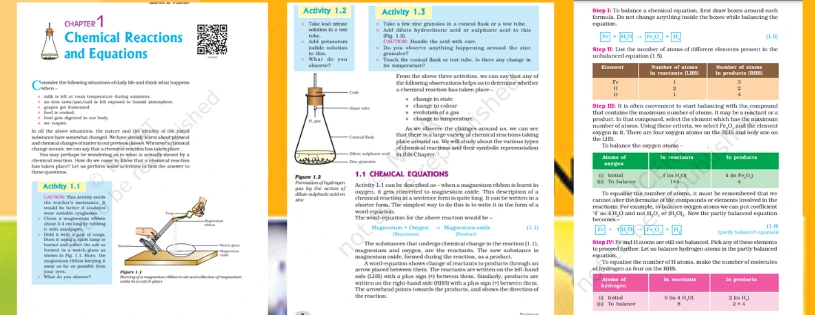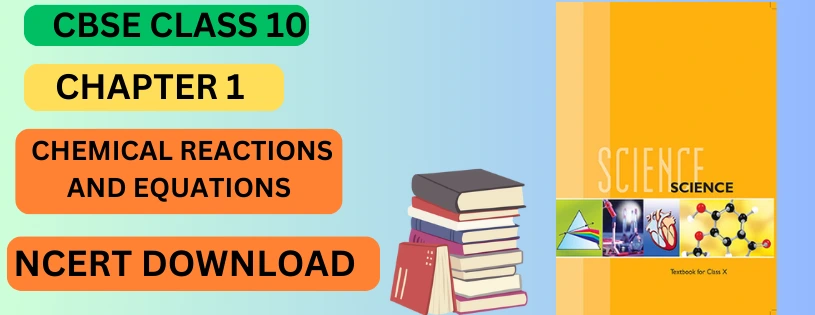In the introduction to Class 10 CBSE NCERT Science Chapter 1 on "Chemical Reactions and Equations," students embark on a journey to understand the fascinating world of chemical transformations.
CLASS 10 SCIENCE (CBSE NCERT) – CHAPTER 1 CHEMICAL REACTIONS AND EQUATIONS
The chapter introduces the concept of chemical reactions, emphasizing the observable changes that occur when substances interact. It explores the significance of balancing chemical equations as a fundamental skill in representing these reactions accurately. Through practical examples and real-world applications, students gain insights into the conservation of mass and the role of reactants and products in a chemical equation.
What is a Chemical Equation?
Chemical equations make use of symbols to represent factors such as the direction of the reaction and the physical states of the reacting entities. Chemical equations were first formulated by the French chemist Jean Beguin in the year 1615. Chemical reactions can be represented on paper with the help of chemical equations, an example of which is represented below (for the reaction between hydrogen gas and oxygen gas to form water).2H2 + O2 → 2H2O
Symbols of Elements and Their Valencies
A symbol is a chemical code for an element. Each element has a one or two-letter atomic symbol, which is, in most cases, the abbreviated form of its name.
Valency is the combining capacity of an element. It can be considered as the number of electrons lost, gained or shared by an atom when it combines with another atom to form a molecule.
Writing Chemical Equations
Representation of a chemical reaction in terms of symbols and chemical formulae of the reactants and products is known as a chemical equation.

• For solids, the symbol is “(s)”.
• For liquids, it is “(l)”.
• For gases, it is “(g)”.
• For aqueous solutions, it is “(aq)”.
• For gas produced in the reaction, it is represented by “(↑)”.
• For precipitate formed in the reaction, it is represented by “(↓)”.
Balancing of a Chemical Reaction
Law of Conservation of Mass
According to the Law of Conservation of Mass, no atoms can be created or destroyed in a chemical reaction, so the number of atoms for each element on the reactants side has to balance the number of atoms that are present on the products side.
In other words, the total mass of the products formed in a chemical reaction is equal to the total mass of the reactants participating in a chemical reaction.
Balanced chemical equation
The chemical equation in which the number of atoms of each element on the reactants side is equal to that of the products side is called a balanced chemical equation.

Download Mathematics notes
The General Form: A typical chemical equation consists of reactants on the left side and products on the right side, separated by an arrow indicating the direction of the reaction. The numbers preceding the chemical formulas, known as coefficients, represent the stoichiometry of the reaction, providing insights into the ratio of reactants and products.
Balancing Act: One of the early challenges students face is balancing chemical equations. This crucial step ensures the conservation of mass, reflecting the fundamental principle that matter is neither created nor destroyed in a chemical reaction. The art of balancing involves adjusting coefficients to achieve equilibrium on both sides of the equation.
Stoichiometry Unveiled: Chemical equations go beyond being mere symbolic representations; they offer a window into the world of stoichiometry. The coefficients in a balanced equation reveal the mole ratios of reactants and products, enabling precise calculations of quantities involved in a reaction. This mathematical aspect adds depth to our understanding of chemical transformations.
Classifying Reactions: Chemical equations also serve as a guide to categorize different types of reactions. Students encounter various classifications, such as synthesis, decomposition, displacement, and double displacement reactions. These categories provide a structured approach to analyzing and predicting the outcomes of diverse chemical processes.
Real-World Applications: The relevance of chemical equations extends far beyond the classroom. From understanding the combustion of fuels to elucidating biological processes within our bodies, chemical equations are the language through which scientists decipher the complexities of the natural world. An appreciation of these equations is vital for anyone curious about the intricate dance of atoms and molecules.
Types of Chemical Reactions
Taking into consideration different factors, chemical reactions are grouped into multiple categories.
A few examples are:
● Combination
● Decomposition
● Single Displacement
● Double displacement
● Redox
● Endothermic
● Exothermic
● Precipitation
● Neutralisation
CBSE Class 10 NCERT Mathematics Topics for a Strong Foundation (NCERT DOWNLOAD)
| Chapter Name |
Chemical Reactions and Equations |
| Topic Number |
Topics |
| 1.2 |
Balanced Chemical Equation |
| 1.3 |
Implication of a Balanced Chemical Equation |
| 1.4 |
Types of Chemical Reactions |
Steps for Balancing Chemical Equations
The changes that occur during a chemical reaction are represented by a chemical equation.
Reactants → Products
The equilibrium of all chemical equations must be maintained. This means that on both sides of the arrow, the number of each sort of atom must be the same.
Chemical equations are balanced using coefficients. A coefficient is a numerical value that is added to the front of a chemical symbol or formula. It indicates the number of atoms or molecules of the material involved in the process.
Place coefficients in front of symbols or formulas as needed to balance a chemical equation so that the same number of each type of atom appears in both reactants and products.
For example,
Zn + HCl → ZnCl2 + H2
The balanced equation is
Zn + 2HCl → ZnCl2 + H2
Hit and trial method: While balancing the equation, change the coefficients (the numbers in front of the compound or molecule) so that the number of atoms of each element is the same on each side of the chemical equation.
CBSE Class 10 Board Exam Sample Paper
.webp)
Download Question Bank
[Previous Year Question Solution Maths Download Button]
[Previous Year Question Solution Science Download Button]
FAQ
Q:1 How can chemical reactions be represented?
Ans: Chemical reactions can be represented through chemical equations, where reactants are written on the left side and products on the right side. Symbols and formulas depict the involved substances.
Q:2 What are the different types of chemical reactions?
Ans: Common types of chemical reactions include synthesis, decomposition, combustion, displacement, and redox reactions. Each type has specific characteristics and outcomes.
Q:3 How do you balance a chemical equation?
Ans: Balancing a chemical equation involves adjusting coefficients to ensure that the number of atoms for each element is the same on both sides of the equation, maintaining the law of conservation of mass.
Q:4 What is the significance of the Law of Conservation of Mass in chemical reactions?
Ans: The Law of Conservation of Mass states that the total mass of the reactants in a chemical reaction is equal to the total mass of the products. This principle highlights the preservation of mass during chemical transformations.
Q:5 Can you provide examples of everyday chemical reactions?
Ans: Examples include combustion (burning of fuel), rusting of iron, baking a cake, digestion of food, and photosynthesis in plants. These reactions occur in our daily lives, showcasing the ubiquitous nature of chemical processes.


Post a Comment